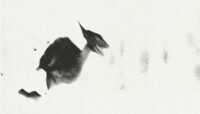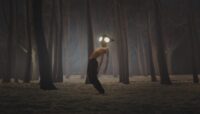
“Beach House”
from the album Welcome Joy
2009
iTunes
It was something of a disappointment when Pretty Girls Make Graves split up. Not only were they a bright hope musically but they had such a great name, too. Still, without their demise, we’d have never had the pleasure of what Derek Fudesco did next, and what he did next has come up with a fantastic record.
The Cave Singers stated their intent with their debut album Invitation Songs, a collection of rustic American folk songs that grabbed the attention with simplistic production and an almost campfire sing-a-long quality to proceedings.
Welcome Joy sees the band expanding upon the promise displayed on their debut offering, and whilst for many there is often a case to be made for the “tricky second album” syndrome, we instead find The Cave Singers taking confident strides forward.
Although the folk feel of their first album can still be found on Welcome Joy, there is a distinctly more rock tinged flavor to many of these songs. There’s still something undeniably pastoral about The Cave Singers, though. You can practically see the band set up on the back porch overlooking a swamp, guitar amp crackling quietly, a single snare drum with brushes nestled on a weathered skin, with an array of simplistic percussion instruments piled alongside it.
In the shadows, seated in an old battered chair, sits Pete Quirk. He’s got his eyes closed, deep crow’s feet run out towards his ears like trenches of emotion, his fists are clenched in his lap and he’s singing as if these songs just have to be released into the ether.
Fudesco might lend some pulling power The Cave Singers due to his past exploits, but it’s Quirk’s voice that seals the deal. Despite having a voice several registers higher than Mark Lanegan, his delivery is incredibly similar. It’s as if these songs mean everything to him, and that makes each of these tracks all the more intriguing. It almost doesn’t matter what he’s singing about because you simply get lost in the atmosphere that he and the band create.
Equally, it’s almost impossible not to hear influences seeping into the band’s music. At times Welcome Joy sounds as if it’s a long lost Fleetwood Mac album — possibly shelved somewhere between Rumours and Tusk. Quirk’s voice recalls Lindsey Buckingham’s frequently throughout on Welcome Joy, and second track “Leap” would fit easily into Rumours‘ tales of recriminations and lost love. And hey, there’s a neat skiffle beat that echoes that of “Second Hand News,” too. Similarities to the good old country rockin’ of Creedence Clearwater Revival can be found scattered liberally over the album too, while “At the Cut” (amongst others) revels in the teachings bestowed upon the band by numerous spirituals and the writings of the good book “The Gospel of Gospel.”
Shrine mimics the slightly eastern influenced guitar runs you’d find on The Doors’ “The End.” To begin with, there’s so much space in this song it’s positively scary — it’s if you’re alone with Quirk in a wooden shack, and he’s starting to lose the plot. Thankfully, just before he reaches for the woad and his copy of Deliverance the drums turn up and a glorious duelling female vocal gets him back on track again.
Almost as vital as the band’s more filled-out, more considered sound this time around is the production of Colin Stewart. He doesn’t let the band ever sound too clean and manages to retain an air of authenticity, allowing for the occasional buzz of amps to bleed through and ensuring that Quirk sounds as if he’s singing these songs with his head laid on your shoulder.
Welcome Joy is an album that has its roots embedded as equally in history as in histrionics. As such it is a fascinating listen, frequently pushing the listener between the outer limits of joy, sorrow, and something approaching religious epiphany. This is a remarkable album in every sense.



Happy 5th birthday! Also, you are far better at photoshop than I.